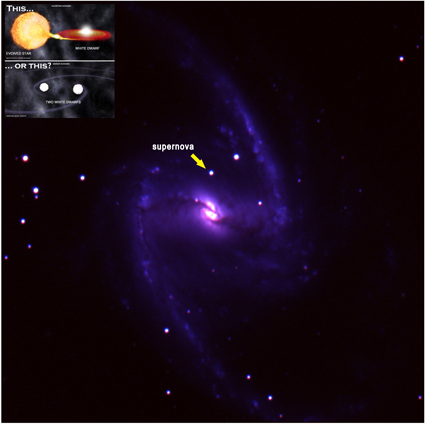Astronomers Discover Two Distinct Populations of Thermonuclear Supernovae
A team of astronomers[1,2], led by Xiaofeng Wang of Tsinghua University, reveal that there are two distinct populations of thermonuclear explosion of a “white dwarf” (a dense star with a mass around that of the sun). They show for the first time that such particular stellar explosion, dubbed as type Ia supernova, can be grouped into two distinct classes, according to the ejecta velocities measured around the maximum brightness. The class with relatively higher ejecta velocity is found to be associated with more metal-rich and perhaps younger stellar systems than the class with lower velocity. This is a very significant result as this particular kind of supernova plays a very important role in the current attempts to map the expansion history of the Universe. Observations of type Ia supernovae in 1998 have led to the discovery of accelerating expansion of the Universe which was awarded the 2011 Nobel Prize in Physics. However, it is embarrassing that the physics of these explosions of Type Ia supernovae, as well as their progenitor systems, remain elusive till today. Fortunately, the dataset of well-observed Type Ia supernovae has grown significantly in recent years and astronomers are able to probe the statistical behavior of supernova properties and establish a link to the host galaxy environments where they exploded. The authors studied 188 nearby Type Ia supernovae with good photometric and spectral coverage and discovered that the supernovae with low and high expansion velocities are fundamentally different from each other. This research is published on Science Express on Mar. 07 2013 [DOI:10.1126/science.1231502], entitled “Evidence for Two Distinct Populations of Type Ia Supernovae”.
The explosion of a white dwarf star
Type Ia supernovae are believed to be the results of thermonuclear explosions of white dwarf stars close to the critical Chandrasekhar mass limit. But the typical mass of a white dwarf is not large enough to trigger an explosion, it is suggested that either merging of two white dwarfs in a binary system or continuous accretion of mass from a companion by a white dwarf is required to reach that limit. The two different scenarios imply that progenitor stars vastly differ in age, metallicity, and circumstellar environment.
“The progenitor systems, and therefore the explosion physics of Type Ia supernovae can be probed by analyzing their spectral properties and compare them with the birth environments such as locations and surface brightness within host galaxies etc.” says Xiaofeng Wang of Tsinghua University, the lead author of this study.
The supernovae and their host galaxies
The study found that the group of type Ia supernovae with higher expansion velocities are substantially more concentrated in the inner and brighter regions of their host galaxies than are the normal-velocity group. Furthermore, the high-velocity class tends to inhabit larger and more-luminous hosts. These results suggest that high-velocity type Ia supernovae likely originate from relatively younger and more metal-rich progenitors than the normal-velocity ones, and are restricted to galaxies with substantial chemical evolution.
The authors suggest that the high-velocity features are perhaps formed due to the density increase caused by interactions of the supernova ejecta with the material around the exploding white dwarf, which could be an accretion disk or a filled Roche lobe. The angular variations in observing such an interacting system may explain the variation of the polarisation of the light and its correlation with the ejecta velocity for high-velocity supernovae. This is consistent with the observations that high-velocity type Ia supernovae are generally associated with dusty circumstellar environments than low-velocity ones.
“Perhaps, the high-velocity type Ia supernovae are from single white dwarf accreting matter from companion stars, whereas the normal-velocity subclass are from mergers of double white dwarfs”. says Lifan Wang of Texas A&M University, co-author of the paper.

Type Ia supernovae are the explosions of white dwarfs in binary systems. The companion stars may be a giant, subgiant, a main sequence star, or another white dwarf. The spectral properties of these Type Ia supernovae may be different for different progenitor systems, and these properties may be correlated to locations of the supernovae in their host galaxies.
Implications on supernova cosmology
The discovery of a dependence of ejecta velocity on progenitor environment could be relevant when using type Ia supernovae as cosmological yardsticks, since these two populations of type Ia supernovae have different colors around maximum light and their ratio may change with redshift. The relative fraction of the high-velocity and normal-velocity populations might become smaller at great distances due to a decrease in the high-velocity supernova rate in low-metallicity environments and the increased difficulty of spectroscopically classifying supernovae in the central regions of distant galaxies.
“Our findings perhaps identify an evolutionary effect that is related to the cosmological applications with type Ia supernovae.” says Alexei V. Fillipenko of University of California at Berkeley.
Notes:[1]: This is a coordinated Tsinghua University/Texas A&M University/University of California, Berkeley Press Release.
[2]: The team consists of Xiaofeng Wang, Lifan Wang, Alex Fillipenko, Tianmen Zhang, and Xulin Zhao
ContactsXiaofeng Wang, Tsinghua University, Beijing, 100084, China, Tel: 8610-62794785, Email: wang_xf@mail.tsinghua.edu.cn
Lifan Wang, George P. and Cynthia W. Mitchell Institute for Fundamental Physics and Astronomy, Department of Physics, Texas A&M University, College Station, TX 77843, USA, Tel: 1-979-8454881; Email: wang@physics.tamu.edu
Alexei V. Fillipenko, University of California, Berkeley, CA 94720, USA, Tel: 1-510-852-4829; Email: alex@astro.berkeley.edu

